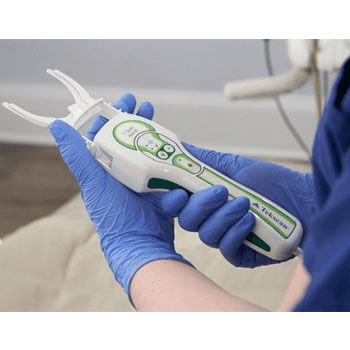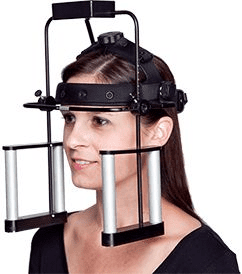Dental lasers address a variety of issues — everything from teeth whitening to treating gum disease and canker sores and surgically reshaping your gums, making them handy and versatile tools. When you need any type of dental work done, the last thing you want is an uncomfortable procedure and a prolonged, painful recovery time. One of the major benefits of using lasers in our practice is that they cause less swelling and bleeding, which mean you heal faster.

Nearly EVERY dental procedure performed impacts occlusion! Poor occlusion affects quality of life. T-Scan™ provides dynamic occlusal measurement – revealing the level and timing of force on individual teeth and the occlusal stability of the overall bite.


JT-3D, or “Jaw Tracking”, allows Dr. Powell to analyze jaw movement in a dynamic way. The most relevant procedures include chewing, speaking, range of motion, and swallowing.

Surface EMG is the worldwide standard method for recording muscle-specific activity in skeletal muscles. It has been proven reliable in numerous studies over many years and is a clinical procedure that can easily be performed in Dr. Powell’s office. This information is invaluable to creating beautiful dentistry that works with the patient’s physiology for optimum results.

The goal of the M-Scan™ project is to provide an extremely simple, fast and accurate means of evaluating splint efficiency in the office.

3D dental imaging is rapidly becoming the standard of care in all of dentistry, not just specialty fields. A cone beam CT captures digital images of teeth, soft and hard tissues, and nerve pathways. With a single 360-degree pass around the head, the CBCT can capture more precise images than 2D X-rays. These images can be used across many different applications. Digital images are superior to a typical pano or intraoral image, spotlighting areas not visible any other way. Recently, we had a patient come in with extreme tooth pain. Dr. Powell took a 3-D image and was able to diagnose one root had a fracture and the tooth needed to be extracted. With a cone beam in-house there is no need to send our patients driving across town or waiting days or weeks for another appointment at a different office. Within a few minutes Dr. Powell can view those images with you and discuss next steps. It’s quick, simple, and easy.
At Richard Powell DDS, we offer clear alignment trays. The trays are custom fitted to the teeth, making them virtually unnoticeable when laughing, talking and eating with other people. Patients receive a sequence of trays, each of which is slightly different than the one before. The aligners provide a slight resistance to the teeth, forcing them to move into alignment over time. With this treatment option, adults and teens can achieve the smiles they’ve always wanted without feeling self-conscious about the mode of treatment.
If you have crooked or crowded teeth that are embarrassing to you or otherwise preventing you from achieving optimal oral health, this option could be the solution for you. Visit your us for a complete consultation to find out if you could benefit from clear orthodontics.
Clear alignment treatments are different for everyone, but most patients can achieve their ideal smiles within one to two years. During that time, you can expect to make occasional dental visits to monitor your progress.
Following your treatment, you will no longer need to wear Invisalign® trays. However, you will need to wear a retainer each day to help protect your new smile. It is also important to continue visiting your dentist for routine check-ups and twice-yearly cleaning.
Periodontal disease is one of the most common diseases in America, affecting nearly 65 million adults over age 30. There are two types of periodontal disease – gingivitis and periodontitis. Each refers to an accumulation of bacteria along the gum line though one is more severe than the other.
that in addition to being one of the most prevalent diseases in America, periodontal disease is also one of the most preventable? Proper brushing and flossing techniques can help prevent the accumulation of tartar, which harbor harmful bacteria along the gum line. According to the American Academy of Periodontology, certain lifestyle habits and systemic conditions like smoking and diabetes can also contribute to the development of periodontal disease. Talk to your periodontist or dentist about the changes you can make to reduce your chances of developing gingivitis or periodontitis.
If you are experiencing any of the signs or symptoms of periodontal disease, seek treatment as soon as possible. Found in its earliest stages, periodontal disease is more easily treated. Left untreated, periodontal disease is likely to progress, requiring more invasive treatments and potentially causing total tooth loss.
Your treatment experience will vary according to the stage of your disease. If gingivitis is the problem, you’ll need a thorough professional cleaning and a topical antibiotic. On the other hand, a diagnosis of periodontitis may require surgery, as well as bone or tissue grafting. Talk with your periodontist about the treatment options best for you.
Yes. Your post-treatment care guidelines will vary according to the type of treatment you have and may include an at-home antibiotic and special instructions for keeping the treatment site clean in the days following your procedure. You will be advised to maintain your treatment results by attending periodic dental cleanings and exams in the future – perhaps more frequently than the standard twice-yearly recommendation. You’ll also be encouraged to begin flossing and using a mouth rinse daily once you have recovered from your periodontal treatment.
Dental crowns and bridges are custom-fitted tooth prosthetics that are used to replace or restore damaged or missing teeth. Crowns – also known as caps – are fixed over the surfaces of natural tooth structures or dental implants. Bridges are used to fill in the gaps left by missing teeth and are anchored in place by the natural teeth or crowns nearest the empty space. Both crowns and bridges are non-removable and must be cemented in place by a licensed dentist. Patients who get crown or bridges to restore their smiles achieve both the function and appearance of natural, healthy teeth.
that the Etruscan civilization were the first to use crowns as a means of restoring damaged teeth? In fact, the materials they used – ivory, gold, and bones – were still the standard in dentistry as recently as the 20th century, when porcelain crowns were first invented. Today, crowns and bridges are customized specifically for the patient’s bite and can usually be placed in as little as one or two dental visits. With proper cleaning and regular dental check-ups, crowns and bridges can last many years, or even a lifetime.
If you have a tooth that is damaged or decayed, but still intact, a dental crown may be right for you. If your tooth is missing, but its former position is surrounded by other tooth structures, a bridge may be the solution for you. Schedule an office consultation to determine whether you could benefit from crowns or bridges.
If you are a candidate for a crown or bridge, your teeth will be reduced to ensure a proper fit. An impression will then be taken of your bite and used to fabricate a mold for the crown or bridge. If you are choosing porcelain prosthesis, its color will be matched to the natural shade of your other teeth. If a dental lab is making your crown or bridge, you may be fitted with a temporary restoration until the permanent one is ready for placement.
Your teeth will need time to heal following the crown and bridge placement process, so it is normal for you to experience some sensitivity – especially to hot and cold. Additionally, you may experience soreness in the gums surrounding your restorations, though this is usually manageable with ibuprofen and should subside within a few days.
Teeth whitening procedures are used to brighten the appearance of a patient’s smile – sometimes by as many as 5 to 10 shades in a single session. According to the American Dental Association, teeth whitening procedures have become some of the most popular esthetic dental treatments among patients throughout the country, including. Professional teeth whitening services can be performed in an office setting or prescribed for take-home use by a patient. In comparison to over-the-counter teeth whitening treatments, professional whitening uses stronger whitening agents that deliver faster and more effective results.
that the teeth naturally darken as we age? Furthermore, certain foods, beverages, medications and habits can contribute to a darker, yellowed, or stained smile. However, it is possible to erase years of stains in a single professional whitening session and sustain those results for many years with proper maintenance. According to the American Academy of Cosmetic Dentistry, professional whitening is best maintained by a combination of good oral care and take-home whitening treatments as recommended by your dentist.
You may be a candidate for professional teeth whitening if you are experiencing discoloration, but otherwise have healthy teeth and healthy gums. Schedule a consultation with a dentist to find out if tooth whitening could be right for you. Some patients, such as those who are pregnant or sensitive to whitening agents, may not be candidates for professional whitening.
Teeth whitening consists of a thorough cleaning and polishing of the teeth, with all debris carefully removed. Your dentist will then protect your gums before applying a whitening agent to the surface of your teeth. The product will be activated and left on the teeth for several minutes before being washed off with water. Your results will vary according to the natural shade of your teeth and degree of discoloration, but it is normal for patients to experience a lightening of several shades in a single visit.
It is normal to experience some tooth sensitivity following a professional whitening treatment. You may be instructed to avoid consuming highly pigmented beverages for at least 24 hours to prevent the teeth from becoming stained again. Examples include tea, coffee and wine. Depending on your results and long-term teeth whitening goals, you may also be sent home from your procedure with an at-home whitening kit for later use.